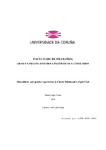Masculinity and gender expression in Chuck Palahniuk’s Fight Club

View/
Use this link to cite
http://hdl.handle.net/2183/41007Collections
Metadata
Show full item recordTitle
Masculinity and gender expression in Chuck Palahniuk’s Fight ClubAuthor(s)
Directors
Liste Noya, JoséDate
2024Center/Dept./Entity
Universidade da Coruña. Facultade de FiloloxíaDescription
Traballo fin de grao (UDC.FIL). Inglés: estudios lingüísticos y literarios. Curso 2023/2024Abstract
[Abstract] The main focus of this project is the examination of the representation of the masculine
gender in Chuck Palahniuk’s 1996 novel Fight Club. Throughout this analysis I aim to explore
the novel’s depiction of the state of masculinity at the turn of the 20th century, from the origin
and cause of the perceived “crisis of masculinity” experienced by the narrator of the book, to
the social and material remedies that emerged as a direct result of this critical situation,
concluding with an exploration of the consequences of the main character’s retaliation against
the larger cultural context.
The first section of this paper is devoted to providing historical context for the fluid
nature of the definition of masculinity, as well as the discontent it can generate in men. The
western idea of maleness has always been susceptible to change, fluctuating according to a
myriad of other social, historical and economic factors. In the late 20th century, one such shift
had taken place. In Fight Club, the essence of manhood, which is variable, as mentioned, but
also unattainable, is proven to be frustrating and harmful for men. As the most perfect ideal of
masculinity is placed always in the past, it is impossible for men to ever achieve a totally
satisfactory form of gender expression, which results in a constant fear of social rejection and
general unease. Thus, men’s psychological state and position in society become, consciously
or subconsciously, linked to their performance of masculinity.
Following this initial segment, I analyze the consequences of men’s detrimental
relationship to their own gender, as depicted in the novel. Once the narrator’s despondency
reaches a boiling point, his first instinct is to lash out against femininity. Perceived as the
complete opposite of masculinity, it is selected by the narrator as the leading cause of male
dissatisfaction. The conclusion he reaches is that society, and therefore the men raised by that
same society, have become over-feminized. He then seeks to return to a previous idolized
version of maleness. The narrator aims to abandon post-industrial consumerist masculinity for
post-war masculinity. In doing so, he creates a schizoid alternate personality, Tyler Durden, to
represent this seemingly more meaningful version of masculinity. Tyler, then, creates fight
club, as a space devoid of any femininity, where men can forge bonds and reclaim aspects of
masculinity now disdained by mainstream society, mainly, the enactment of violence.
The third and final section deals with the escalation and consequences of the narrator’s
pursuit of post-war masculinity. Unconsciously, he ends up recreating and perpetuating the
same systems that had led to his initial ennui. He realizes too late into the novel that he cannot
find a remedy for his troubles in another version of manhood, as dominant standards of male
gender expressions are unsatisfying by design. Instead, I posit that the novel offers gender
hybridity as a solution to the oppressive principles of the gender binary.
In conclusion, Fight Club’s author recognizes the dysfunctional state of masculinity and
the pain it can inflict on men. At the same time, he condemns acts of violence as ultimately
useless in providing an alternative to a significant gender expression. As mentioned above, the
novel seems to shine a positive light on individuals who embody both feminine and masculine
qualities, existing outside the confines of traditional gender norms. Rather than a return to the
past and more rigid separation between the genders, the path forward would be an evolution,
an incorporation of the best qualities of both masculinity and femininity.
Keywords
Chuck Palahniuk
Fight Club
Masculiinity
Crisis of masculinity
20th century
Gender
Femininity.
Fight Club
Masculiinity
Crisis of masculinity
20th century
Gender
Femininity.
Rights
Os titulares dos dereitos de propiedade intelectual autorizan a visualización do contido deste traballo a través de Internet, así como a súa reproducción, gravación en soporte informático ou impresión para o seu uso privado e/ou con fins de estudo e de investigación. En nengún caso se permite o uso lucrativo deste documento. Estos dereitos afectan tanto ao resumo do traballo como ao seu contido. Los titulares de los derechos de propiedad intelectual autorizan la visualización del contenido de este trabajo a través de Internet, así como su reproducción, grabación en soporte informático o impresión para su uso privado y/o con fines de estudio e investigación. En ningún caso se permite el uso lucrativo de este documento. Estos derechos afectan tanto al resumen del trabajo como a su contenido.





